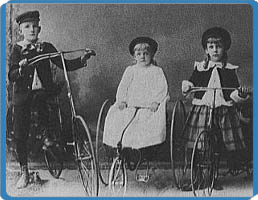|


The wheel is the most crucial element of the bicycle: it allows
the rider to roll over the ground with great speed and efficiency. Historians
believe the wheel originated in Mesopotamia sometime around 3,500 BC. While
the Sumerians did not pedal their way through ancient Mesopotamia, animal-powered
wheeled chariots and carts helped haul goods and people for thousands of
years. During the industrial revolution in the 19th century, advances in
materials and engineering made it possible to use the wheel effectively
in human-powered machines. The modern bicycle, complete with a steel frame,
a chain drive, steel wheels and spokes, and pneumatic tires, would emerge
in the late 1800s.
|

The wheels on these bicycles were made of steel but lacked pneumatic tires
(with the possible exception of the boy's bike). Some bikes made for small
children are still made with solid tires. This photograph was taken around
1910.
LIBRARY OF CONGRESS
|
|
|
On the Road
While the use of the wheel was widespread in ancient times,
it did have limitations. The resistance to the motion of a wheel can vary
tremendously depending on the surface on which it is traveling. A rough
road is much harder to roll over than a smooth one. The Romans were aware
of this and developed a massive network of paved roads. While this may have
been the first time in history that roads were improved to facilitate the
wheel, it certainly wasn't the last. In the United States in the 1890s,
cyclists successfully lobbied for improvements in roads nationwide, and
with cycling the nation's most popular sport at the time, legislators listened.
|
|
The Ordinary
When most people think about early bicycles, the high-wheelers
of the late 1800s come to mind. These early models had names such as the
"Ordinary" or "Xtraordinary." In England, these bicycles
were also known as "penny farthings" because the large and small
wheels were reminiscent of the large one-penny coin and the smaller farthing
coin.
The pedals were attached directly to the front wheel of
the high-wheelers. The larger the front wheel on an "Ordinary,"
the farther the cyclist would travel with each turn of the pedals. Exploratorium
Senior Scientist Paul Doherty explained, "Every time the pedals would
go around once, that whole giant front wheel would go around once. So, for
one cycle of the bicyclist's legs he might go 140 inches (3.556 meters),
a tremendous distance forward." This made pedaling up hills quite difficult,
but allowed for great speed on the flats.
|
|

BICYCLE INSTITUTE OF AMERICA
|
This image shows an "Ordinary" bicycle. What is somewhat out of
the ordinary is that the cyclist in the photograph is a woman. Although
cycling became quite popular with women in the late 1800s there were still
social taboos associated with it.
|
|
|


|
The Exploratorium's Paul Doherty talks about the early high-wheeled bicycles.
|
|
While the high-wheels were quite efficient, they were
also dangerous: the cyclist was very high off the ground and perched precariously
over the front wheel. So, while the high- wheelers broke new speed and distance
records, they quickly gained notoriety for the dangers involved in riding
them. The slightest obstacle in the road could result in a nasty head-first
fall. "Headers" or "taking a header" were common terms
used to describe an all-too-frequent problem. With a high center of gravity
and narrow tires made of solid rubber (which occasionally could roll off
their rims), high-wheeled bicycles were designed for speed, not for safety.
|
|
|
The Wheel
Page: 1 of 3
Select "Forward" below to continue
|

©
Exploratorium
|